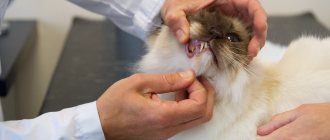In cats, ear diseases are one of the most common among all groups of diseases. The main reason is the complex anatomy of cat ears, which is subject to potential risks. Problems can affect both the visible parts of the ear (pinna, external auditory canal) and those that are inaccessible to the human eye (middle ear, inner ear). An article from “Murkoshi” will help you figure this out.
1) Signs of ear problems 2) Diagnosis 3) Basic ear diseases 4) Treatment 5) Prevention
Signs of ear problems
Normally, cats' ears are shiny and clean, but not wet. The skin inside the ear is a uniform pale pink color. There is no visible discharge in the ear; at most, there may be a small accumulation of light yellow wax without a strong odor. If a kitten develops an ear disease, it will manifest itself with some of the following symptoms:
1. The cat shakes its head and purses its ears. 2. The cat actively scratches its ears and even scratches them until they bleed, resulting in crusts and wounds appearing. 3. There is no (or weakened) reaction to sounds. 4. If you touch the ears at the base, the cat presses them and tries to escape, bites and scratches. 5. Swelling, unnatural growths and bumps are found inside.
Read more: The cat has a swollen ear: what to do
6. The skin in the ear is red, peeling, there are signs of inflammation and crusting. 7. Discharge in the ears ranges from whitish to dark brown. 8. A putrid or sweetish (unnatural) odor comes from the ears. 9. Shortness of breath and nasal discharge are observed. 10. There may be problems with motor coordination and balance.
Can ear infections in cats be prevented?
The best way to prevent another painful ear infection is to check your ear regularly for redness, marks or odor. Healthy ears are pale pink in color, there is no visible debris or odor, and there is virtually no earwax.
By checking regularly, you can catch a potential ear infection early and treat it before it gets worse. It's best to have your veterinarian show you how to clean your cat's ear, or do it yourself.
Never insert a cleaning device into the ear canal itself unless your veterinarian has instructed you to do so.
Diagnostics
Murkoshi specialists recommend that if you find one or more of the symptoms listed above, immediately take your pet to a veterinary clinic or call a specialist at home. There are many causes of ear diseases in cats; signs, as a rule, can indicate several diseases at once, so without special education it is impossible to make an accurate diagnosis. And untimely treatment can seriously worsen the condition of a mustachioed pet.
Ear diseases in cats can be parasitic, fungal, infectious, inflammatory and traumatic. The color of the discharge from the ears will help determine the cause of the disease (normally, if there is any, it is light yellow - this is the color of earwax). If they are whitish (similar to a curd mass) or yellow, then most likely it is a fungal disease. Yellow-brown discharge indicates bacteria (eg, bacterial otitis media). And if dark brown masses, similar to coffee grounds, accumulate in the ear, then this may indicate that the cat has ear mites.
But for an accurate diagnosis, tests are needed - for example, an ear smear. This will be done at a veterinary clinic. The doctor may resort to a more accurate diagnosis. In any case, immediately or after a while they will tell you what exactly the problem with your ears is and what medications you need to treat it with.
What are the signs of an ear infection in a cat?
The cat will show its discomfort by scratching or pawing at the ear, shaking or tilting its head in the direction of the painful ear.
Other symptoms to watch out for include:
- Black or yellowish discharge
- Redness or swelling of the ear or ear canal
- Buildup of wax on or near the ear canal
- Discharge from the ear that resembles coffee grounds (a symptom of ear mites).
- Strong smell
- Hearing loss
- Loss of balance or confusion
Major ear diseases
Let's look at the most common ailments that often occur in our beloved purrs. 1. Otodectosis . Caused by a microscopic parasite - ear mites. Most cats become infected with it through contact from already sick animals. Ear mites are not transmitted to humans; they are only dangerous to cats and dogs. However, a cat’s good immunity will help cope with the parasite without any special consequences, so either kittens (whose immunity is not yet sufficiently developed) or animals with weakened immunity for one reason or another are susceptible to the disease.
Read more about this disease: Treatment of ear mites in cats
2. Otitis media . One of the most common ear diseases in kittens. In fact, this is a whole group of diseases associated with inflammatory processes in different parts of the ear - external, middle or internal. Most often, otitis media accompanies other ailments and pathologies and develops against their background. The most common are parasitic (complication after otodectosis) and bacterial otitis. If left untreated, otitis media can lead to serious consequences, including complete deafness.
Read more about otitis media: Treatment of otitis media in cats
3. Eczema of the ear . As a rule, it is a complication of inflammation of the outer ear. The most common causes of the disease are foreign bodies, water or chemicals entering the ear.
Read more about what eczema is: How to cure eczema in a cat
4. Polyps and tumors . Both are neoplasms (growths) in the ears. Only polyps are considered benign, and tumors are considered malignant. Polyps occur more often in young animals, and tumors occur more often in older animals. Both formations are removed surgically. In the absence of qualified help, they lead to extremely serious consequences: a polyp can block the eardrum (as a result - its rupture and complete deafness), and a tumor can even lead to death. Fortunately, tumors in cats are relatively rare.
Characteristics of ear diseases
Concha hematoma in cats
Appears against the background of received bites from other animals or blows. A bruise forms if the vessels of the auricle rupture. In this case, the area begins to fill with blood. Due to the pressure, the auditory organ swells for a few minutes after the rupture, causing a feeling of discomfort.
If proper treatment is not started at the first symptoms, the neoplasm remains, and subsequently the accumulated fluid passes into the scar tissue phase. This phenomenon can externally irreversibly change the organ of hearing. The size of the tumor depends on the pressure and the level of compliance of the tissues located near it. Hematomas occur on the inner plane of the ear and are much less common externally. Damaged ears increase in volume, droop; if you palpate, they are hot and painful. If the disease is left to chance, the pain increases, and bruising can lead to necrosis of the ear cartilage.
Concha hematoma in cats
Treatment consists of removing the hematoma with a syringe or surgery. You cannot do this on your own! After opening the hematoma, the doctor will prescribe a course of antibiotic such as Ampicillin.
Lymphatic extravasation of the ears in cats
It has similar symptoms and occurs for the same reasons as a hematoma. The only difference is in the method of therapy. When you are sick, applying cold or heat is harmful. If lymph accumulates, the liquid is also withdrawn with a syringe. When the procedure does not give a positive result, surgery is necessary. During the operation, the doctor trims the hair, treats an area of skin with an antiseptic, then cuts the skin, removes the contents and finally applies stitches. After the operation, antibiotics are also prescribed for 3-4 days.
Ear scabies in cats
Belong to the most common ailment. The disease is also called otodectosis, which is characterized by brown “islands” on the inside of the ear. They are similar in appearance to coffee. The disease is caused by ticks, which can be easily seen. It is necessary to carry out treatment in a timely manner so that there is no inflammation and the animal does not die.
Otodectosis of the ears
When the disease is advanced, the animal becomes apathetic, body temperature rises, and pathological conditions of the nervous system—convulsions—occur.
How to identify ear mites?
The tick looks like a red, brown parasite. The main signs of the parasite include twitching of the ears, turning the head from side to side, bad odor from the ear, and the presence of clusters of brown color. The animal will scratch its ears, so wounds may appear in this area. In this case, a veterinarian will help the pet owner. The doctor will determine the disease, clarify the diagnosis, and prescribe therapy. Self-medication will only harm your cat's health, but there is one option that can be used for treatment at home.
How to treat otodectosis at home?
The procedure for treating ear mites does not require special knowledge and skills, so everything can be done at home. But when we talk about “advanced cases,” it is best to contact a veterinarian straight away.
How to carry out treatment? Be sure to clean the ear of crusts and pus before using medications. Use hydrogen peroxide or Chlorhexidine applied to a cotton swab. To clean the ear, you can take cotton swabs that are moistened with alcohol. The procedure is repeated 1-2 times a day. Only after the cat’s ears have been treated with alcohol or peroxide can the medicine be used as prescribed by a veterinarian.
Treatment consists of cleaning the ear with a cotton swab containing medication. Before visiting a doctor, it is permissible to use an effective long-acting product against fleas, lice, ticks and other skin parasites. Before instilling drops of “Bars”, “Tactic”, “Amit”, “Frontline Spot-on”, “Acaromectin” or “Otoferonol”, you need to clean your ears from old crusts. Additionally, “Stronghold” drops are added to the withers.
Otoferonol drops
Important! Bars drops for treating ticks are especially effective. They must be applied to the skin in the neck area to prevent the animal from licking it off.
Video - Otodectosis in cats
Otitis in cats
Otitis is characterized by inflammation. The symptoms resemble the same signs as in the case of ticks. These are redness, high levels of wax in the ears, irritation. scratch its ears so often . The disease should only be treated by a veterinarian, since complications may occur if the treatment is improper. The pet owner must take the cat to a veterinarian and follow the doctor's recommendations.
Treatment consists of treating the ear with Chlorhexidine and removing wax using an exudate solution. After removing all the crusts, the ear is instilled with Otipax, Sofradex or Anandin Plus .
Otipax drops
Neoplasms in the auricle
Neoplasms appear more often in older animals in the area covering the ear canal. Such growths are considered benign. However, an ulcerated bleeding tumor in the external auditory canal is difficult to treat, and the animal is often euthanized. Tumors look like small nodules in which an infectious process occurs. The doctor may order a collection of cells or tissues (biopsy) for diagnostic purposes. In some cases, benign growths can be treated with surgery, but not in an advanced stage.
Treatment involves prescribing a course of antibiotics and corticosteroids. Additionally, there are painkillers like Motrin or Advil.
Painkiller Motrin
Eczema or dermatitis of the ear
This problem refers to inflammation of the outer ear. The factor of the disease is considered to be the entry of a foreign body into the organ, the penetration of liquid. The pet feels unpleasant irritation. The skin swells and turns red. A dark-colored discharge with an unpleasant odor is noticeable in the area. The animal holds its head on its side.
In this case, you can remove the foreign body from the ear using a syringe with three percent hydrogen peroxide. Wet areas are treated with astringents, such as a 2% silver solution, 3-5% solution of picric or boric acid. In case of severe itching, Cordiozol is used and corticosteroid ointments such as Hydrocortisone and Geocorton are prescribed.
But in any case, it is better to consult a doctor who will rinse the ear and prescribe the necessary medicine.
Inflammatory processes
Let's consider inflammatory processes in the ear and their types. With otitis media, inflammation occurs in the ear. There are 3 types:
- external;
- middle;
- interior.
Treatment of otitis media in cats at home
All types differ from each other in the prerequisites for their occurrence. In addition, it should be noted that there is a variation of the disease: the outer and inner ear.
External inflammation. With this type, the first step is to exclude infection with parasites, especially ticks. With external inflammation of the ear, swelling, redness, and severe irritation appear, causing the cat to try to scratch the area with its claws. When the disease is detected very late, the animal’s hair may fall out and pus may ooze from the affected area. There are several factors for contracting this type of disease:
- as a result of injury or splinter;
- when the animal is hypothermic;
- the disease may appear as a result of an infectious process caused by pathogenic microorganisms or viruses;
- due to fungus;
- accumulation of wax in the ear;
- allergy.
Streptococci and staphylococci can provoke inflammatory processes in the ears of animals
Inflammatory damage to the auditory tube, which causes deterioration in the ventilation of the tympanic cavity with the formation of otitis media. This type of illness is rare. It may appear as a complication of external inflammation if the therapy was carried out incorrectly. The cause of the appearance may also be an injury.
Reference! The initiators of the disease are often streptococci and staphylococci. The disease occurs with purulent discharge in an acute form.
Streptococci and staphylococci can provoke inflammatory processes in the ears of animals
Signs and treatment
The severe consequences of inflammatory processes are manifested by lifelong pathology of coordination, the animal loses hearing. The signs of the disease are as follows:
- the cat refuses to eat, tilts its head in the direction affected by the disease;
- swelling is noticeable;
- increased body temperature;
- acute purulent discharge;
- the animal walks hesitantly.
Does your cat refuse to eat? She's probably unwell
Inflammation of the inner ear appears against the background of complications of previous types of ear disease. The pathology process is severe, with pronounced symptoms:
- hearing loss;
- problems with the direction of body movement;
- lack of appetite;
- when palpating the temples, pain occurs.
A long course of antibiotics is prescribed as treatment. This may be a series of cephalosporins for 25-30 days with further adjustment of therapy in accordance with the results of bacteriological studies. In case of relapse, surgical treatment or drainage of the ear cavity is often used.
Treatment
The first step in the treatment of cat ear diseases is to cleanse the auricle of the contents using lotions, such as Ottoclin, Bars, Globalvet, etc. The lotion dissolves dirt, removes secretions out, after which all that remains is to clean them off with a cotton pad . After cleaning the ear, if it was dirty, medicine is instilled there, depending on the causative agent of the disease. The procedures should be carried out for as many days as the doctor recommends.
Antiseptic and antihistamine drugs, as well as insecticidal drops, are used against ear mites. When treating otitis, Otipak, Sofradex or Anandin Plus drops are used. For ear dermatitis, treatment is carried out with a 3-5% solution of boric or picric acid and an ointment such as “Hydrocartisone” or “Geokarton” is applied. After treatment for ear diseases is completed, the cat must be shown to the doctor, he will again do an analysis. He will look at how much the condition has improved and give a conclusion: the end of the procedures or the need to change the drug and continue treatment.
Often, with ear diseases, cats require a drug to relieve itching; tablets or drops can be used orally. Especially if otitis media has developed due to an allergy, then Zordex, Zyrtec, and Tyrosine are used in dosages for animals. Sometimes, when the itching cannot be removed immediately, cats are put on a special collar, attached to the neck with a strap.
To treat parasitic otitis media, you will also need drops on the withers against ticks. It is advisable to repeat the procedure after 28 days to consolidate the result. In this case, you will need to take care of the hygiene of the room in order to protect the cat from re-infection.
The place where the animal lives must be vacuumed, and things (beds, toys, bowls, etc.) must be washed or rinsed thoroughly. Other animals living in the same apartment should also be treated, because even if they do not have ear discharge, they will most likely still be infested with ear mites. Allergic otitis occurs with the main agents - these are bacteria and yeast fungi, malacesia. Drugs for their treatment: “Suralan”, “Mometamax” and the most modern drug “Posatex”.
How to help an animal
Hot ears in a cat are not a pathology in themselves, which means that trying to cool only one ear (for example, by applying ice compresses) is pointless. The first thing to do is to examine the animal for other symptoms. If they are not there, then you should leave the cat alone for 20–30 minutes and feel the ears again - in a healthy animal, by this time the blood flow will normalize and the skin will no longer be hot.
When fiery ears are still a symptom of some kind of disease, it is necessary to begin treatment. It depends on the diagnosis:
- If the ears are burning due to severe stress, then first you need to create the most comfortable conditions for the cat and remove all irritants. There is no need to forcefully try to pick up the animal or stroke it (this will only increase the stress). It is better to provide maximum peace, but leave water and tasty food nearby. If after a couple of days the cat’s mental well-being is not restored, veterinarians will prescribe sedatives: Clomipramine;
- Cat Baiyun;
Kot Bayun is a sedative medicine based on natural herbal ingredients
- Fitex;
- Vetspokoin;
- Anti-stress;
- Phospasim;
- Vetranquil.
- Surolan;
Amitrazine is a veterinary drug that is used for cats in the treatment of pathologies caused by sarcoptic mites
During treatment of otitis media, ear mite infection, and after surgery, the cat must be wearing a medical collar that prevents the animal from scratching the sore ear.
If the cat has a fever
If the ears are hot, you need to make sure that the animal’s body temperature is normal. If you don’t have a thermometer, just feel the animal’s nose - it should be cold and wet when awake. If you have a temperature measuring tool at home, you should use it. For an adult cat, readings below 37.5˚C and above 40˚C are a serious reason to immediately contact a veterinarian. Fever occurs when:
- infectious diseases;
- poisoning;
- tumors;
- allergies.
Video: how to correctly measure a cat's temperature
Sometimes an emergency situation arises when it is impossible to quickly get an appointment with a specialist. Inaction during hyperthermia is dangerous, therefore the following measures are allowed to eliminate fever:
- Cover the animal for a couple of minutes with a towel soaked in cold water (do not put the cat in an ice bath, as this can cause heart attacks).
- Give the cat echinacea tincture at the rate of 1 drop per 1 kg of animal weight (dilute the drug with water in a ratio of 1:5).
- Place the antipyretic suppository Cefekon (50 mg for an adult cat, 25 mg for a kitten).
Remember, fever is a dangerous symptom. Even if you manage to knock it down, it is very important to take your cat to the vet as soon as possible. He will conduct an examination and find out the exact cause of the fever, which will help prescribe the correct treatment.
Many cat owners panic if their pets' ears become hot. But, according to experts, flaming ears themselves are not a reason to suspect a disease. You need to worry if the animal's general body temperature rises, it itches constantly, refuses to eat, and sleeps poorly. Such symptoms are already a reason to visit a veterinarian, find out the reason for the cat’s poor health and immediately begin treatment.
Prevention
The Murkoshi team draws your attention to the need for preventive measures, only in this case you will save your kitten from ear diseases. The most important preventive action is pet hygiene. Teach your kitten from an early age to constant ear cleaning. The procedure must be carried out carefully so as not to injure the tail or cause him pain.
Read more about how to clean ears: How to clean a cat's ears
Clean your cat's ears delicately, speaking gently and stroking them. If everything is done correctly, there will be no complications or resistance to the procedure on the part of the pet. Also, a mandatory measure should be treatment against parasites - external and internal - 2 times a year.
Read more: How to treat a cat for parasites
If you spend time on cat hygiene, then ear diseases will bypass her. But if you still notice alarming symptoms (the cat intensively scratches its ears, does not allow them to be touched, discharge appears in the ears, etc.), do not hope that “maybe it will go away on its own,” but immediately contact a specialist. Only with a correct diagnosis and appropriate prescription is it possible for your pet to recover quickly!
Video “How to clean the ears of a cat and dog”
To prevent the consequences, as in the photo, of the formation of plugs and mites, watch the video for the correct process of cleaning cats’ ears.
Was this article helpful?
Thank you for your opinion!
The article was useful. Please share the information with your friends.
Yes
No (100.00%)
X
Please write what is wrong and leave recommendations on the article
Cancel reply
Rate the benefit of the article: Rate the author ( 7 votes, average: 3.71 out of 5)
Discuss the article:
How to identify the disease
It is very important to contact a specialist in a timely manner so that he can conduct a full examination of your pet and identify any abnormalities in the health of your furry pet. And to do this, you need to know the main symptoms of ear diseases in cats. Treatment must be prompt in order to easily and quickly eliminate the disease.
In general, all symptoms, regardless of the type and nature of the disease, are quite similar. Therefore, the main task of the cat owner is to notice them and visit the veterinarian. A detailed examination of the ear cavity, followed by taking tests (if necessary) and making a diagnosis is the prerogative of a veterinarian with the appropriate education and experience.
So, what should a cat owner be wary of:
- The animal often shakes its head, as if trying to shake something out of its ear.
- The auricle is noticeably swollen.
- The cat scratches his ear so actively that he scratches it until it bleeds.
- An unpleasant odor emanates from the auricle.
- When the ears are touched, the animal reacts inappropriately - growls, rushes, runs away, howls in pain.
- Incomprehensible
- Loss of coordination and movement in cats.
As you can see, the list is quite long. If you notice any of these symptoms, it would be a good idea to contact your veterinarian. Of course, it might just be a harmless nuisance like a scratch or a mosquito bite. But it’s still better to be too vigilant and waste a few hours of your time than to risk the health and even life of your pet.
Now let’s briefly talk about various ear diseases in cats. Photos will create a more complete picture.
Ear structure
To get a more complete picture, it would be a good idea to learn about this. This is a very complex and delicate instrument that allowed weak animals to survive for many thousands of years.
The ear is divided into three parts by specialists: inner, middle and outer. In turn, each of the parts is further divided into several more.
The parts of the outer ear are the eardrum, the pinna and the ear canal. Their main function is to capture sound and transmit vibrations to the middle ear.
In turn, the middle ear consists of two interconnected chambers. The anvil, malleus and stapes are also located here. Their main function is to amplify sound waves and transmit them to the inner ear.
Finally, it is the inner ear that receives all sounds, which are subsequently processed by the brain. By the way, the labyrinth is located here - the vestibular apparatus, which is responsible for the cat’s balance. Therefore, some diseases that affect a cat's ears can cause loss of coordination and balance. As a result, a dexterous, beautiful, graceful animal turns into a clumsy, barely standing parody of itself. So it is very important to know the symptoms of ear disease in cats. Perhaps thanks to this you will be able to contact a veterinarian in a timely manner and save your pet from such a sad fate.
Necrosis of the auricle
A truly terrible disease, which usually occurs only in cases where milder forms (for example, hematoma or other minor mechanical damage) were not cured in time.
When infection gets into the wounds, inflammation begins, and then ulcers and necrosis of some areas of the ears - this is necrosis. Blood circulation deteriorates, cartilage tissue begins to rot, and the ear becomes severely deformed. A characteristic smell of rotting flesh appears.
Unfortunately, treatment is only possible through surgery. Veterinarians will have to remove either the entire ear or individual areas that have undergone necrosis.
Hematoma
Another common problem. A cat may well damage its ear during a walk or in a conflict with other animals - domestic or stray. An insect bite may also be the cause. Sometimes cats themselves damage their ears, for example, by scratching them too actively.
The symptoms are quite simple - a swelling appears that is hot to the touch. When touched, the cat flinches, runs away, or becomes aggressive. In some cases, the hematoma resolves and does not cause problems. But sometimes an infection can get into an open wound (and the cat will probably continue to scratch the ear, causing additional damage), which can lead to necrosis of the ear cartilage. After this, the ear will droop and it will be impossible to restore it.
You need to act as decisively as possible. The owner should immediately fix the ear with a bandage and apply cold in the first two days after receiving the wound. After this, you need to apply irritating ointments and heat.
If home treatment does not bring the desired results, you will have to visit a doctor. He will conduct an examination and, if necessary, open the hematoma, carefully removing the dried blood.











